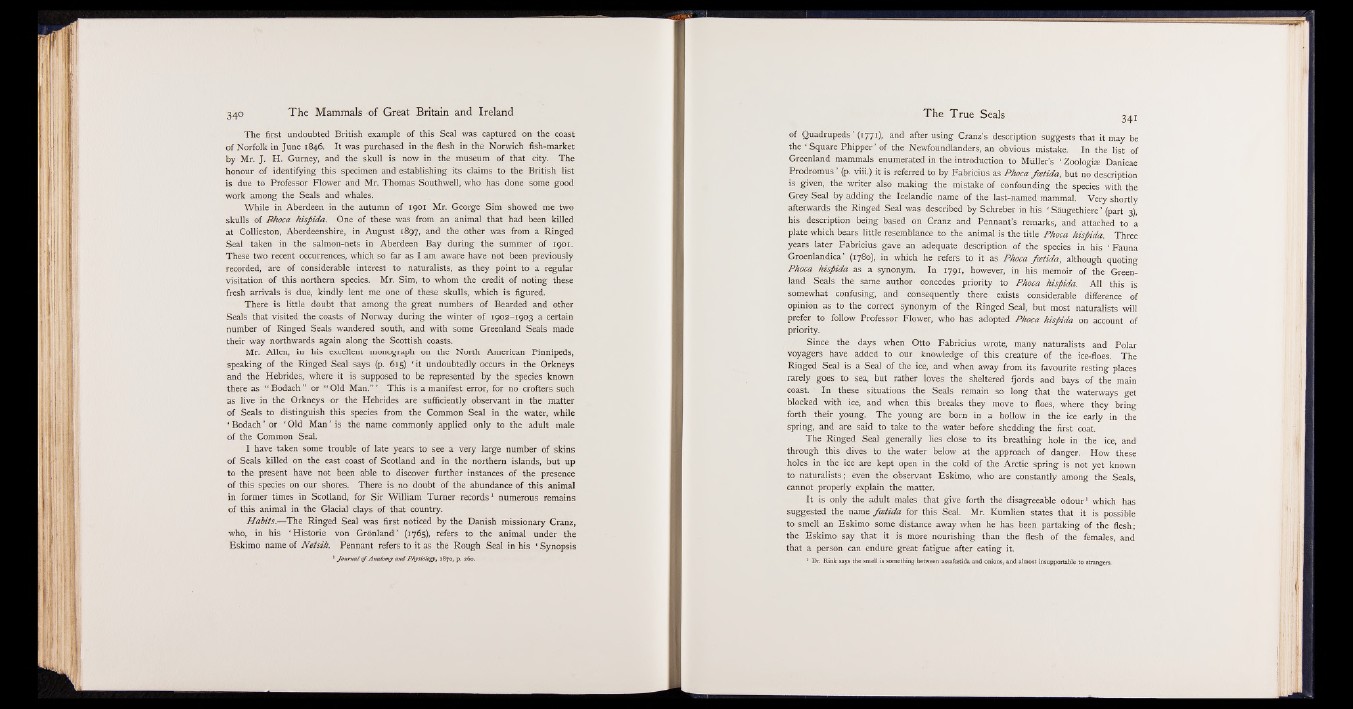
The first undoubted British example of this Seal was captured on the coast
of Norfolk in June 1846. It was purchased in the flesh in the Norwich fish-market
by Mr. J. H. Gurney, and the skull is now in the museum of that city. The
honour of identifying this specimen and establishing its claims to the British list
is due to Professor Flower and Mr. Thomas Southwell, who has done some good
work among the Seals and whales.
While in Aberdeen in the autumn of 1901 Mr. George Sim showed me two
skulls of Rhoca hispida. One of these was from an animal that had been killed
at Collieston, Aberdeenshire, in August 1897, and the other was from a Ringed
Seal taken in the salmon-nets in Aberdeen Bay during the summer of 1901.
These two recent occurrences, which so far as I am aware have not been previously
recorded, are of considerable interest to naturalists, as they point to a regular
visitation of this northern species. Mr. Sim, to whom the credit of noting these
fresh arrivals is due, kindly lent me one of these skulls* which is figured.
There is little doubt that among the great numbers of Bearded and other
Seals that visited the coasts of Norway during the winter of 1902-1903 a certain
number of Ringed Seals wandered south, and with some Greenland Seals made
their way northwards again along the Scottish coasts.
Mr. Allen, in his excellent monograph on the North American Pinnipeds,
speaking of the Ringed Seal says (p. 615) ‘ it undoubtedly occurs in the Orkneys
and the Hebrides, where it is supposed to be represented by the species known
there as “ Bodach” or “ Old Man.” ’ This is a manifest error, for no crofters such
as live in the Orkneys or the Hebrides are sufficiently observant in the matter
of Seals to distinguish this species from the Common Seal in the water, while
* Bodach ’ or ‘ Old Man ’ is the name commonly applied only to the adult male
of the Common Seal.
I have taken some trouble of late years to see a very large number of skins
of Seals killed on the east coast of Scotland and in the northern islands, but up
to the present have not been able to discover further instances of the presence
of this species on our shores. There is no doubt of the abundance of this animal
in former times in Scotland, for Sir William Turner records1 numerous remains
of this animal in the Glacial clays of that country.
Habits.—The Ringed Seal was first noticed by the Danish missionary Cranz,
who, in his ‘ Historie von Grönland’ (1765), refers to the animal under the
Eskimo name of Netsik. Pennant refers to it as the Rough Seal in his ‘ Synopsis
1 Journal o f Anatomy and Physiology, 1870, p. 260.
of Quadrupeds’ (1771), and after using Cranz's description suggests that it may be
the ' Square Phipper ’ of the Newfoundlanders, an obvious mistake. In the list of
Greenland mammals enumerated in the introduction to Muller’s »‘‘Zoologim Danicae
Prodromus ’ (p. viii.) itMreferred to by Fabricius as Pkoca fcetida, but no description
is given, the writer also making the mistake of confounding the species with the
Grey Seal by adding the Icelandic name of the last-named mammal. Very shortly
afterwards the Ringed Seal was described by Schreber in « ‘ Saugethiere ’ (part 3),
his description being based on Cranz and Pennant’s remarks, and attached, to .a
plate which bears little resemblance to the animal is the title Phoca hispida. Three
years later Fabricius gave an adequate description B the species in h iB Fauna
Groenlandica ’ (1780), in which he refers to it as Phoca fcetida, although quoting
Phoca hispida as a synonym. In 179M however, in his memoir of the Greenland
Seals the same author concedes priority to Phoca hispida. All this is
somewhat confusing, and consequently there exists considerable difference of
opinion as to the correct synonym of the Ringed Seal, but most naturalists will
prefer to follow Professor Flower, who has adopted Phoca hispida on account of
priority.
Since the days when Otto Fabricius wrote, many naturalists and Polar
voyagers have added to our knowledge of this creature of the ice-floes. The
Ringed Seal is a Seal of the ice, and when away from its favourite resting places
rarely goes to sea, but rather loves the sheltered fjords and bays of the main
coast. In these situations the Seals remain so long that the waterways get
blocked with ice, and when this breaks they move to floes, where they bring
forth their young. The young are born in a hollow in the ice early in the
spring, and are said to take to the water before shedding the first coat.
The Ringed Seal generally lies close to its breathing hole in the ice, and
through this dives to the water below at the approach of danger. How these
holes in the ice are kept open in the cold of the Arctic spring is not yet known
to naturalists; even the observant Eskimo, who are constantly among the Seals,
cannot properly explain the matter.
It is only the adult males that give forth the disagreeable odour1 which has
suggested the name fa tid a for this Seal. Mr. Kumlien states that it is possible
to smell an Eskimo some distance away when he has been partaking of the flesh;
the Eskimo say that it is more nourishing than the flesh of the females, and
that a person can endure great fatigue after eating it.
1 Dr. Rink says the smell is something between assafoetida and onions, and almost insupportable to strangers.